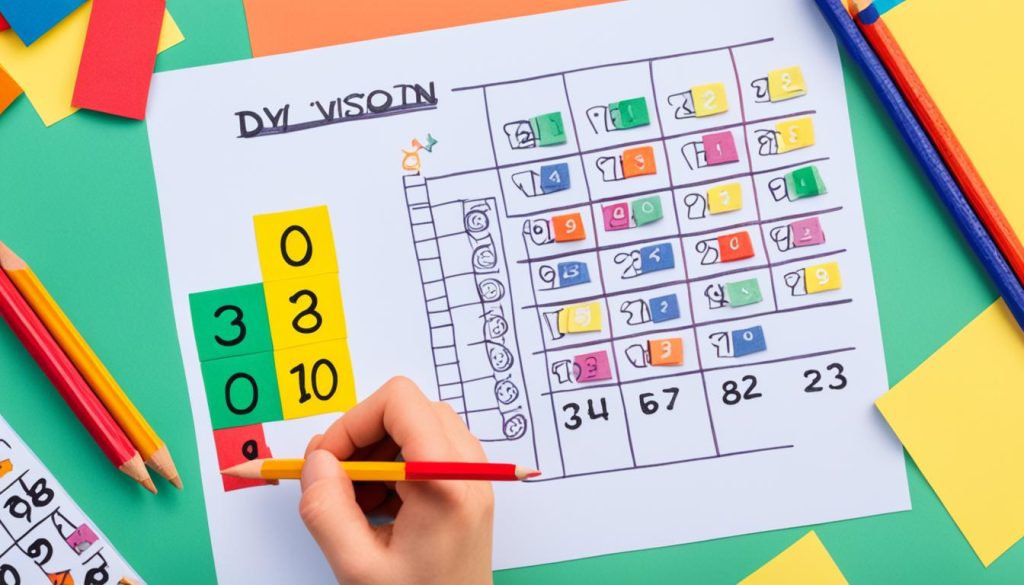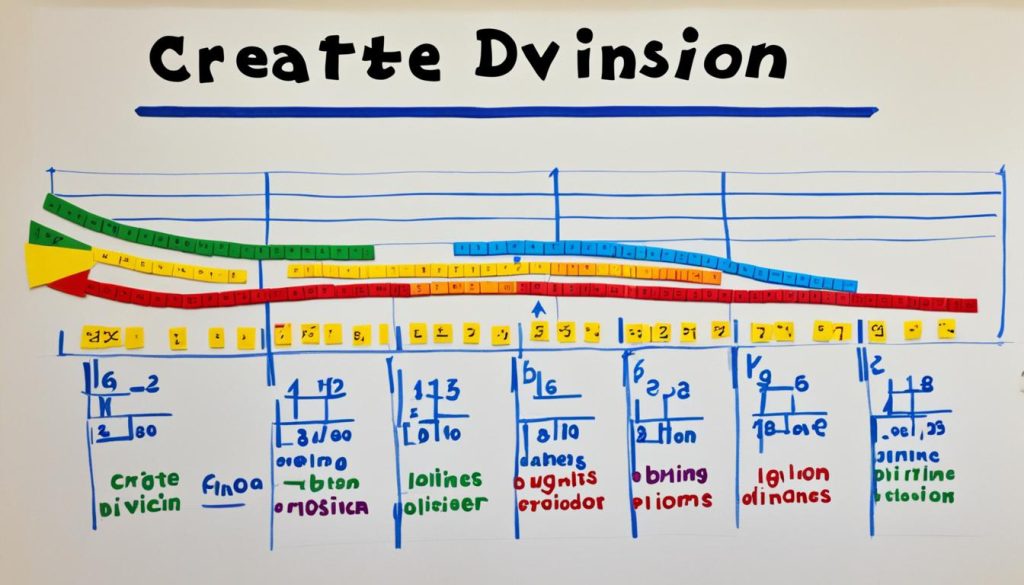Are you struggling with long division? Do you want to learn how to do long division step by step? Look no further – this article will provide you with a comprehensive guide to the division method, ensuring that you become a long division pro!
Long division is a formal method of division often called the bus stop method. It is introduced in Year 6 and is used to divide by larger numbers than the short division method. The long division method is laid out in the same way as short division, with the dividend under the ‘bus stop’ and the divisor to the left. The quotient, or answer, is written on top. The long division method is most often used when dividing by 2-digit or 3-digit numbers and can be used with or without remainders.
Are you ready to master long division? Let’s dive into the step-by-step process of long division!
How to Do Long Division?
The Steps of Long Division
Long division is a step-by-step algorithm used to divide two numbers. It is an important mathematical skill that allows us to find the quotient and remainder when dividing larger numbers.
Step 1: Divide
Begin by dividing the first digit of the dividend (the number being divided) by the divisor (the number you are dividing by). Write the quotient above the line.
Step 2: Multiply
Multiply the quotient by the divisor. Write the product below the dividend, lining up the digits with the corresponding place values.
Step 3: Subtract
Subtract the product from the current digit of the dividend. Write the result below the line, aligning the digits with the corresponding place values.
Step 4: Bring the Next Number Down
Bring down the next digit of the dividend and write it next to the result of the subtraction. This creates a new number to divide.
Step 5: Repeat
Repeat steps 1 to 4 with the new number. Continue this process until you have divided all the digits of the dividend.
Let’s see an example of long division in action:
| Dividend | Divisor | Quotient | Remainder |
|---|---|---|---|
| 125 | 5 | 25 | 0 |
This example demonstrates dividing 125 by 5. The quotient is 25, and the remainder is 0, indicating that 125 is evenly divisible by 5.

Long Division with Different Types of Numbers
Long division is a versatile method that can be applied to various types of numbers, including polynomials and numbers with different digit lengths. Whether you’re dividing by polynomials or multi-digit numbers, the steps of long division remain consistent, although additional steps may be involved for longer digits. Long division can also be used with decimals, where the decimal point is brought down and the division process continues as usual.
Long Division with Polynomials
When dividing by polynomials using long division, the steps are similar to dividing by regular numbers. The goal is to perform polynomial division and simplify the expression as much as possible. Let’s take a look at an example:
| Polynomial Division Example |
|---|
| (4x3 + 2x2 – 6x – 3) ÷ (2x – 1) |

Long Division with Multi-Digit Numbers
Long division is commonly used when dividing by 2-digit, 3-digit, or 4-digit numbers. The process follows the same steps as regular long division, but there may be additional steps due to the longer digits. Let’s consider the following example:
| Multi-Digit Division Example |
|---|
| 1874 ÷ 23 |

Long Division with Decimals
Long division can also be used to divide decimals. The decimal point is brought down and the division is continued as usual. Here’s an example:
| Decimal Division Example |
|---|
| 12.5 ÷ 3.2 |
Long Division Word Problems
Word problems provide a practical application for the long division method, allowing students to solve real-world scenarios. These problems often involve situations such as sharing a certain quantity equally among a number of groups or determining the number of groups that can be formed from a given quantity.
By applying the long division method, students can work through these word problems step by step, allowing them to arrive at the correct solution. By following the division process and applying it to the specific problem at hand, students can gain a deeper understanding of how to use long division in different situations.
Practicing word problems not only reinforces the understanding of the long division method but also helps students develop critical problem-solving skills. By utilizing the long division method in a variety of contexts, learners can become proficient in using this mathematical technique to solve a wide range of word problems.
Example Word Problem
Let’s consider the following word problem:
Samuel has 48 cookies that he wants to distribute equally among 6 friends. How many cookies will each friend receive?
| Steps | Description |
|---|---|
| Step 1 | Divide the total number of cookies (48) by the number of friends (6). |
| Step 2 | Keep dividing until there are no more cookies left to be distributed. |
| Step 3 | Each friend will receive 8 cookies. |
In this example, the division process allows us to determine that each friend will receive 8 cookies. By applying the long division method, students can confidently solve word problems like these and develop their problem-solving skills in a meaningful way.

Tips and Tricks for Teaching Long Division
When teaching long division, it is important to review fundamental concepts such as multiplication, division, and place value. Explaining long division to a child can be done by breaking down the steps and relating them to familiar concepts. It is also important to teach the purpose of long division and its relevance in solving real-world problems. Additionally, incorporating fun and engaging long division activities can help students practice and reinforce their skills in a meaningful way.
Review Fundamental Concepts
Prior to introducing long division, ensure that students have a solid understanding of multiplication, division, and place value. Reviewing these fundamental concepts will provide a strong foundation for learning long division.
Break Down the Steps
When explaining long division to a child, break down the steps into manageable parts. Start with simple division problems and walk them through each step, demonstrating how to divide, multiply, subtract, and bring down the next digit. Relate these steps to familiar concepts, such as sharing objects equally or grouping items into sets.
Highlight the Purpose and Relevance
Help students understand why learning long division is important. Explain that long division allows them to divide large numbers more efficiently and accurately. Show them how long division can be used to solve real-world problems, such as dividing a quantity of objects among a group of people or calculating the number of groups that can be formed from a given quantity.
Incorporate Fun and Engaging Activities
Make long division activities enjoyable and interactive to keep students engaged. Use manipulatives, such as base-ten blocks or counters, to demonstrate the concept of division visually. Play division games or create puzzles that involve long division. Encourage students to solve word problems that require long division, applying their skills in a practical context.
By following these tips and tricks for teaching long division, educators can help children grasp this complex math concept more effectively. By reviewing fundamental concepts, breaking down the steps, highlighting the purpose and relevance, and incorporating fun activities, students can develop a solid foundation in long division and strengthen their mathematical skills.
| Activity | Description |
|---|---|
| Divisibility Dash | A game where students race to determine whether numbers are divisible by specific divisors. This activity reinforces the concept of divisibility and prepares students for long division. |
| Long Division Bingo | A bingo game that requires students to solve long division problems to match the answers on their bingo cards. This activity helps students practice long division in a fun and competitive way. |
| Real-World Division Problems | Present students with real-life scenarios that require long division to solve. For example, ask them to calculate how many pizzas each person can have if there are 5 pizzas and 20 people. This activity demonstrates the practical application of long division. |
| Math Journal | Have students create a math journal to record their long division practice. Encourage them to explain their steps and thought processes in solving long division problems. This activity promotes reflection and reinforces understanding. |
Conclusion
Long division is a crucial method of division that students learn in Year 6. It provides a structured approach for dividing larger numbers and solving complex mathematical problems. By following a set of sequential steps, including dividing, multiplying, subtracting, and bringing down the next digit, students can successfully divide numbers and find the quotient.
Furthermore, long division is a versatile method that can be applied to various types of numbers. Whether dividing polynomials, numbers with different digit lengths, or even decimals, the long division method remains effective and applicable. It allows for precise calculations and helps students gain a deeper understanding of number relationships.
Additionally, long division is not just a mathematical concept; it has real-world applications. By using long division to solve word problems, students can apply their skills to practical scenarios. Whether it’s distributing objects equally among groups or determining the number of groups that can be formed, long division provides a systematic approach to problem-solving.
Teaching long division involves reviewing the necessary foundational concepts, explaining the steps clearly, and providing engaging activities to reinforce understanding. By mastering long division, students can sharpen their mathematical aptitude, improve problem-solving abilities, and develop a strong foundation for future mathematical concepts.

